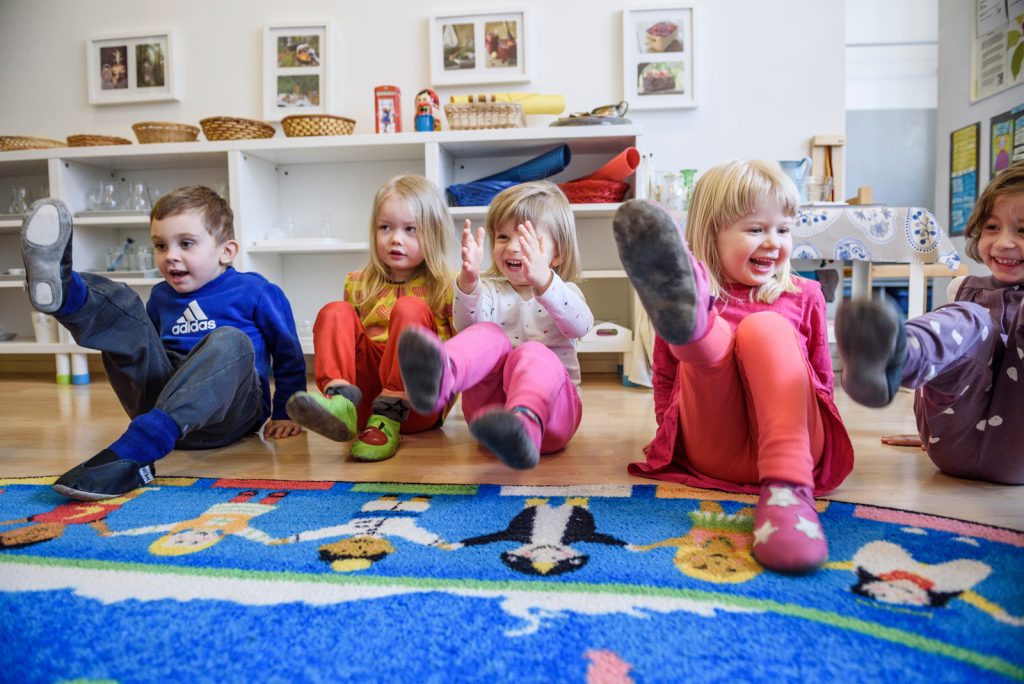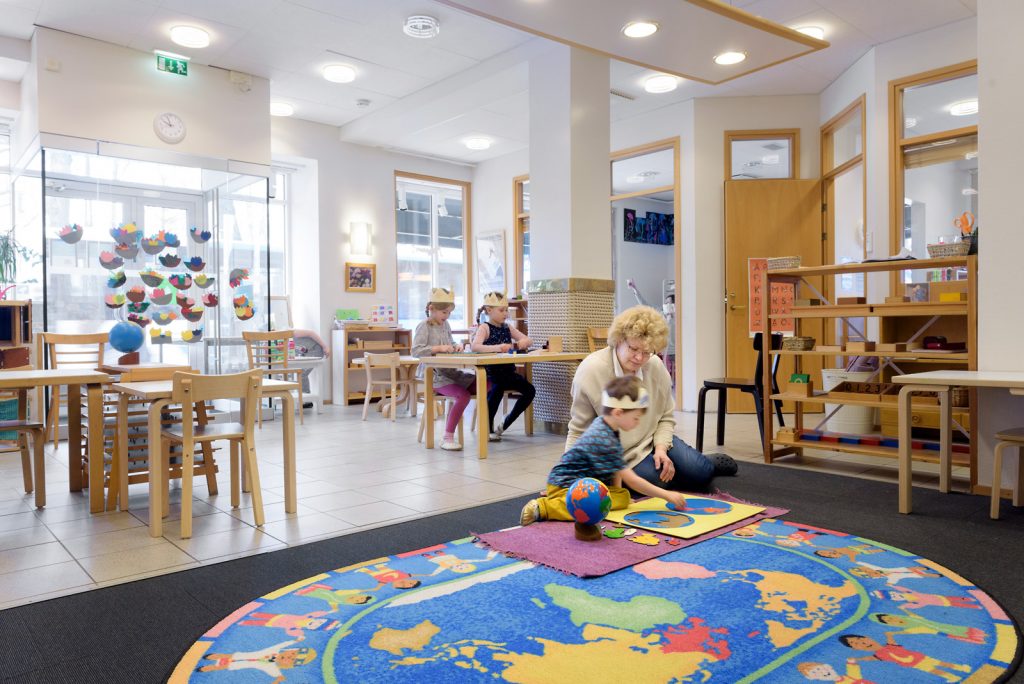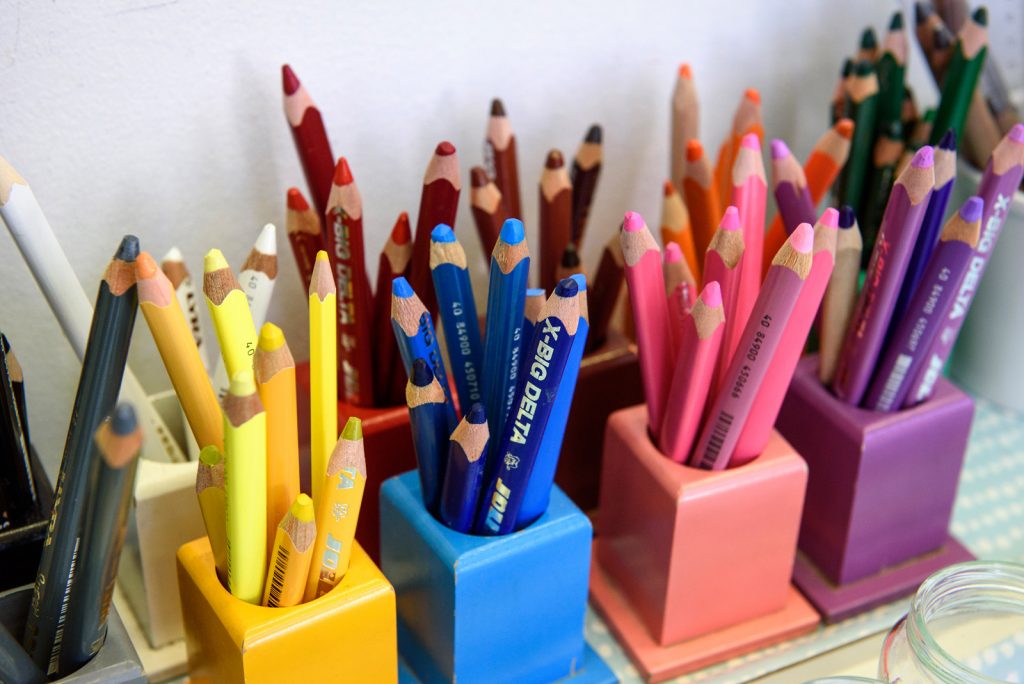Montessori pedagogy is a child-centered educational method developed by Italy’s first female doctor, doctor of medicine and pedagogue Maria Montessori at the beginning of the 20th century. She emphasized the child’s self-determination and natural curiosity. One of the main educational goals of Montessori pedagogy is to support the development of the child’s independency, which includes guidance based on the child’s own initiative.
The child’s development is supported, taking into account their unique periods of development and sensitivity. Education takes place in a prepared learning environment where children have the freedom to try out different tasks based on their own interests.
Maria Montessori’s basic ideas are also the guidelines of our Montessori playschools: less pressure, more joy and consideration of the individual. In a group consisting of children of different ages, we help each other and learn from others. Our learning environment and Montessori equipment inspire children to explore and adventure. We guide them to succeed, discover and invent. With us, the child can learn at their own pace.
We observe the child and guide them to activities according to their preferences and stages of development.
We give the child supplies and materials as well as a framework within which the child can invent and experiment on their own. Every work of art is uniquely beautiful to us.
We help the child to do things for themself. This basic idea applies to our Montessori activities, dressing, eating, and all small everyday chores.
The child chooses which task to perform and does it at their own pace. Completing a task is inspiring and builds a positive self-image.
The little ones learn from the big ones, the big ones help the little ones.
Our aim is to create a familiar and safe environment for the child, with other children and responsible adults to rely on when needed.
Children can concentrate better when they have something to do that genuinely interests them.
The starting point of all learning is the child’s own, natural desire for knowledge and initiative. Based on this, each child in the Montessori environment can progress at their own individual pace.
In our playschools, children’s views and initiatives are noticed, regarded and valued. Children are involved in building and maintaining the environment and community in their own way and with their own unique skills.
We encourage children to listen to others and to value every opinion, to express their own opinion, to accept differences and to be equal.


Maria Montessori identified periods of sensitivity in children, phases of development when learning a certain activity is particularly easy. Periods of sensitivity exist naturally in children. They vary in intensity in different children and can partially overlap each other.
The Montessori environment is carefully planned and prepared. Children are involved in taking care of the environment and developing it as active actors and observers.
The child is encouraged and supported to experiment and do things by themself. We actively observe and document children’s activities and interests in the environment and modify it if necessary. Activities are modeled for children by presenting them concretely. Along with the adult example, we emphasize the importance of children as role models for each other.
Our operating environment contains tools and materials for children’s versatile and multi-sensory work and play. The tools encourage the child to be independent and develop their own activity skills, offering them the the joy of success.


In our playschools the equipment is arranged on open shelves at the child’s height, so that the child can work independently. Children are taught to return the tools to their places after working.
A certain order of things and routines creates a sense of security. The child discovers that they can control their environment, which makes them feel confident.
Montessori work and tools are divided into five main areas. The tools progress step by step from simple to more complex.
spooning, pouring, sweeping, carrying a chair, polishing, washing hands, washing the table, washing clothes, etc.
tools for fine-tuning the senses, for learning to separate and classify, the basics of music with Montessori bells
From the 10-system and basic calculations to fractions
from practicing sounds and sandpaper letters to breaking down grammar
geography, plant and zoology, various scientific experiments. books, music, painting, drawing, crafts are also used in Montessori work and the child can choose them according to their own free will
Montessorin mukaan lapsi kehittyy noin kuusi vuotta kestävien kehityskausien kautta.
0-6 v. varhaislapsuus
Alle 3-vuotias harjoittelee motoriikan hallintaa ja kieli kehittyy. Montessoriympäristössä lapselle tarjotaan erityisesti aistiharjoitteita ja arkielämän aktiviteetteja eli arkipuuhia kuten kaatamisen harjoittelua, pöydän pyyhkimistä tai vaikkapa astioiden tiskaamista. Käytännön elämän töiden ja aistivälineiden lisäksi yli kolme-vuotiaille tarjolla ovat myös äidinkielen, matematiikan sekä kulttuurin alueen välineet.
Lapselle työn tekeminen on tärkeämpää kuin työn tulos. Turvallisen itsenäisyyden, oma-aloitteisuuden ja hyvän itsetunnon tukeminen ovat tärkeitä montessorimenetelmän tavoitteita erityisesti tässä ikäkaudessa.
6-12 v. lapsuus
Toisella kaudella lapsi vähitellen siirtyy abstraktiin ajatteluun konkreettisten välineiden kautta. Tällä kaudella kehittyvät lapsen valmiudet ymmärtää yhä enemmän käsitteellisiä ilmiöitä, ja hänen suhteensa omaan ympäristöönsä muuttuu järkiperäiseksi.
Tällä toisella kaudella lasta kiinnostaa moraalisuus, kulttuurin perusteiden omaksuminen, mielikuvitus, erilaisten asioiden ja tapahtumien syiden etsintä, älylliset ponnistukset ja ryhmässä toimimisen sosiaalisuus. Hän on selkeästi myös enemmän ulospäin suuntautunut toiminnassaan. Lapsi oppii älynsä ja mielikuvituksensa avulla ja tämä kausi on myös kasvavan voiman ja tyyneyden aikaa. Lue lisää kouluikäisten montessorista.
12-18 v. nuoruus
Tässä iässä nuori kasvaa fyysisesti ja käy läpi murrosiän muutoksia. Sosiaaliset suhteet ovat merkittävässä roolissa nuoren elämässä. Oma identiteetti rakentuu ja nuori havainnoi omaa sosiaalista asemaansa. Oppimisen perustana montessorimenetelmässä ovat luovuus sekä itsenäinen oppiminen. Kasvatuksella valmistaudutaan aikuiselämää varten ja siksi opetus on käytännön opiskelua vaikkapa oman yrityksen parissa työskennellen tai huolehtien maanviljelystä tai farmista.
18-24 v. nuori aikuinen
Yhteiskuntamme on muuttunut montessorin ajan jälkeen erityisesti tämän ikäkauden kohdalla, mutta edelleenkin samat kehityskauden piirteet ja tarpeet voidaan tunnistaa. Tässä vaiheessa saavutetaan aikuisuuden kypsyys ja kausi on vakaata ja rauhallista. Tänä aikana aikuisuuteen valmistautuminen kiteytetään ja saatetaan päätökseen. Nuoren aivotoiminta kehittyy vielä edelleen, ja hän tarvitsee ympäristönsä tukea. Nuorella ihmisellä on kuitenkin jo kyky ymmärtää oma osansa maailmankaikkeudessa ja suhteuttaa toimintaansa tähän kokonaisuuteen.